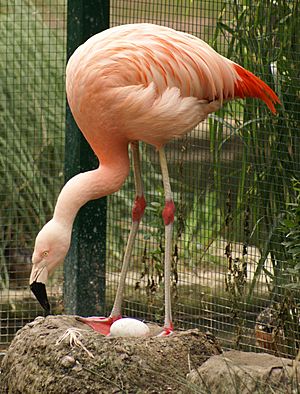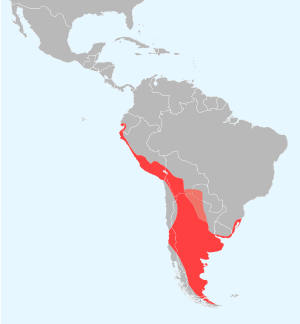Chilean flamingo facts for kids
Quick facts for kids Chilean flamingo |
|
|---|---|
 |
|
| Chilean flamingo with egg at the Tiergarten in Bernburg, Germany | |
| Conservation status | |
| Scientific classification | |
| Genus: |
Phoenicopterus
|
| Species: |
chilensis
|
 |
|
| Synonyms | |
|
|
The Chilean flamingo (Phoenicopterus chilensis) is a large and beautiful bird. It is a type of flamingo that can grow to be about 110–130 cm (43–51 in) tall. This flamingo is related to the American flamingo and the greater flamingo.
You can find Chilean flamingos in South America. They live in countries like Ecuador, Peru, Chile, Argentina, and Brazil. Some have even been brought to the Netherlands. These birds usually live near salty lagoons and soda lakes. Sadly, their homes are sometimes harmed by pollution or changes in the land. Because of this, the Chilean flamingo is listed as a Near Threatened animal.
Contents
What Does a Chilean Flamingo Look Like?
Chilean flamingos have pink feathers. They are pinker than the greater flamingo but not as bright as the Caribbean flamingo. You can tell them apart by their legs. Their legs are grayish, but their "knees" (which are actually their tibiotarsal articulation) are pink.
Another way to spot them is by their bill. More than half of their bill is black. When they are very young, Chilean flamingo chicks are not pink at all. They are usually gray or a light peach color. It takes a few years for them to get their famous pink feathers.
What Do Chilean Flamingos Eat?
The Chilean flamingo has a special bill that works like a filter. It has comb-like parts inside. These parts help the flamingo strain tiny bits of food from the water. They mostly eat algae and plankton. They find this food in places like coastal mudflats, river mouths (estuaries), lagoons, and salty lakes.
How Do Chilean Flamingos Raise Their Young?
Chilean flamingos live in big groups in the wild. They need to be in crowded conditions to feel ready to have babies. During the time they want to breed, males and females do special dances to find a mate. They might swing their heads from side to side together. They also do "wing salutes," where they open and close their wings over and over.
Flamingos sometimes wait a long time to have babies. They only reproduce when the environment is just right.
Building Nests and Caring for Chicks
Both male and female flamingos work together to build a tall, pillar-shaped nest out of mud. The female lays just one chalky-white egg in this nest. Both parents take turns sitting on the egg to keep it warm.
When the chick hatches, it has gray feathers. It takes about two to three years for the chick to turn pink like its parents. Both male and female flamingos can make a special, nutritious liquid in their bodies. It's called "crop milk." They feed this red-colored milk to their young chicks.
Chilean Flamingos in Zoos
Chilean flamingos have a special place in zoo history. The very first flamingo chick born in a European zoo was a Chilean flamingo. This happened at Zoo Basel in Switzerland in 1958.
Pink Floyd the Flamingo
There's a famous story about a Chilean flamingo named Pink Floyd. In 1988, this flamingo lived at the Tracy Aviary in Salt Lake City, Utah. By mistake, his wing feathers were not clipped as usual. This meant he could fly away!
Pink Floyd became a local legend. He would fly to Utah in the winters to eat tiny brine shrimp in the Great Salt Lake. Then, in the spring and summer, he would fly north to Idaho and Montana. Many people loved to see Pink Floyd. He was a popular sight until he flew north in 2005 and was never seen again. People think he might have passed away.
Because the number of Chilean flamingos in the wild is going down, zoos have started special breeding programs. These programs help to raise more flamingos to keep the species strong.
See also
 In Spanish: Flamenco chileno para niños
In Spanish: Flamenco chileno para niños





